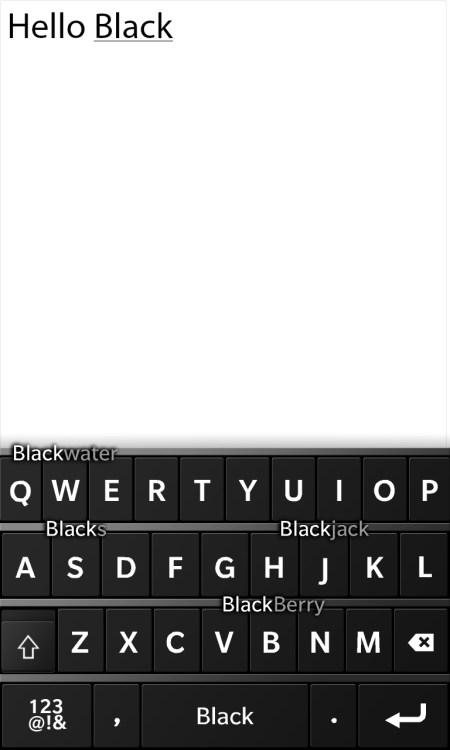BlackBerry World is underway and it started with a keynote from RIM CEO Thorsten Heins. This is really one of the main events and the big expectations were surrounding BlackBerry 10. We knew that we weren't going to see any new hardware, but the chance to see RIM's new OS was exciting enough. During this session, we also saw RIM's plans for BlackBerry 10, what areas of the mobile experience it plans to focus on, and some of the partners RIM has that will help it to achieve its goals.
Right off the bat, Thorsten Heins stressed his dedication to RIM and BlackBerry. He also made some statements that show RIM's recognition of the OS's shortcomings and how it can still be competitive. He said that although BlackBerry is good for media consumption and productivity, it has to be more than that. In an even stronger statement, he said, "It's really important that we don't focus just on consumer use or just on enterprise." In the past, and perhaps still, BlackBerry has been known as an enterprise OS and many cite this as a reason why it has struggled to compete with iOS and Android, two OSes that provide great consumer features. RIM's goal is to strike a balance between the two. As another sign of RIM's new philosophy, Heins stressed that BlackBerry 10 will not be released until it's ready. He said, "We're taking our time to make sure we get this right." Sure, it would have been nice to have new BlackBerry 10 devices this week, but kudos to RIM for not rushing them out. One of the Playbook's greatest downfalls was shipping without key features like native email and calendar support. RIM has apparently learned its lesson.
The thing that everyone wanted to hear about was BlackBerry 10. What does it look like? How does it work? When will we see it? We got a few demos during the keynote that showed off some of the new OS's key features. There was a developer device that attendees could see and use, but it's not final hardware and the software is definitely not complete yet. Aside from things like the keyboard, camera, and web browser, the device didn't have much functionality. Therefore, all we have to go on are the demos from RIM.
A few months ago, we saw a few leaked pictures of BlackBerry 10. Those pictures were definitely real as the unit that Thorsten had on stage contained the same home screen widget designs those pictures showed. A major part of the OS is its UI, called Cascades. Cascades is a design UI created by TAT which RIM acquired in December 2010. It's all about flow. By simply swiping from left to right, you can take a "glance" at the previous app you were using. For example, if you're in your calendar and need to take a quick look at the email you were just reading, instead of completely switching back to that app and then back again to the calendar, you can just swipe the calendar window to the right a little and slide it back to the left when you're done. Or you can swipe all the way to the right to easily switch between apps. This is true multi-tasking; RIM made sure to point out that the apps are actually running in the background and are not just paused when you leave them.

The UI is highly based on gestures. The developer device that attendees were shown did not have any physical navigation buttons and developers were encouraged to make strong use of gesture-based technology when designing their apps. Time and time again, Thorsten emphasized the "flow" of the OS. No one is entirely sure what this means, but the Cascades UI with deep integration of gesture-based technology gives us a pretty good idea. It's not about just about apps, it's about how you move around and use your phone. "We're making you agile and nimble", said Heins of the OS.
Next, the keyboard. "We know that typing for BlackBerry users is really, really important," said Thorsten, "And we know that BlackBerry keyboards are the best. So how are we making this better in BlackBerry 10?" That question was answered by a demo of the new virtual keyboard. (This was particularly interesting since the BlackBerry keyboard everyone loves is the physical keyboard.) The keyboard adapts to you. It learns your typing patterns and has algorithms built-in to make it personalized. It even makes one-handed typing easier. By learning your typing and conversation style, it can predict the word you want to type and that word will appear on the keyboard so you can just swipe it up to your message without having to use both hands to type. It's great to see RIM put this much emphasis on building a great virtual keyboard. We know that their physical keyboards are second to none, but some people want an all-touchscreen device.

RIM also wants to build "the best camera experience" and they showed off a pretty awesome demo. At first, when they said that the BlackBerry 10 camera is "all about technology that allows you to never miss a moment", I thought it was going to another implementation of going from a locked screen to your camera within seconds, similar to what's been emulated from Windows Phone. However, RIM went in another direction. Say you take a picture of two people. In the picture, one person has his/her eyes closed. Instead of having to take a new picture, you can select that section of the picture and manually move through several frames to find one where the person's eyes are open. It's a pretty mind-blowing feature and the audience was clearly impressed. That's only one feature, but it shows that RIM is trying to make the experience the best one possible.
After the look at BlackBerry 10, RIM showed us some of its partners and what apps they're working on. This included a new experience from Pacemaker, a pretty awesome camera app from Occipital that allows you to take 360-degree panoramic photos, new game announcements from Gameloft, including Nova 3, as well as Fish Labs, the creators of Galaxy on Fire, and a demo from digital publishing company Pixelmags which will have a newsstand app that offers time-based subscription services.
Among the many sessions that were held on Tuesday, I attended one that covered the topic of NFC and RIM's partnership with two companies that will implement this technology into BlackBerrys. We all know NFC as a handy technology that can be used to make payments, but INSIDE and HID demonstrated how it can be used for several other practical purposes. For example, INSIDE showed off an app that can be used as an anti-counterfeiting measure. A product (a purse, jewelry, wine bottle, etc.) can be fitted with a special NFC chip that can be scanned by the customer with their BlackBerry. This will prove that it is authentic. Retailers can also use this opportunity to give marketing information to the customer. This can be coupons for that product, related deals or products, information on a loyalty program, and more. In another scenario, NFC can be used while shopping. As a customer adds each item to their cart, they can scan it with their NFC-enabled BlackBerry. Once they reach the cashier, the person will then scan another reader that will tell the computer what items they have so the computer can then calculate the total and give tell them the price to pay. Afterwards, the customer uses NFC to pay, the usage case we're familiar with. This removes the hassle of removing items from the cart to scan, and then putting them back in.
HID, which makes most of the ID badges that people use to access their work office or college dorm room, showed their implementation of NFC. Instead of being issued a card, your NFC-enabled BlackBerry will have the ability to open these doors. This implementation means that provisions can easily be added or taken away. This can be used by employers, home-owners who want to control when service workers can enter the house, and more. They even demoed using this technology to log on to your computer.
All in all, RIM seems to understand where they strayed and what they need to do to get back on track. BlackBerry 10 is a step in the right direction for RIM. It's fresh and contains features and design elements that consumers want and have been switching to other OSes to get. The only problem is that it won't be available until the end of this year and some feel that it may be too late for RIM. Regardless, the mood here is high and most seem to be either super-impressed or at least not disappointed by RIM's announcements. We'll see what Day 2 holds.